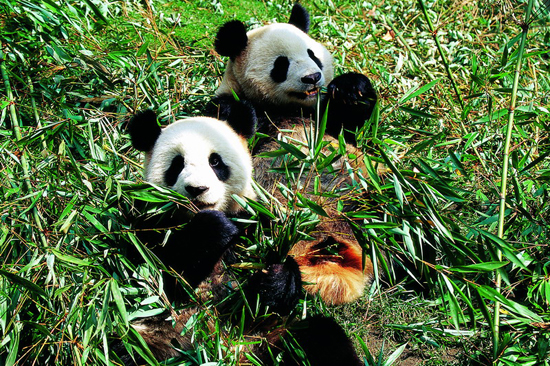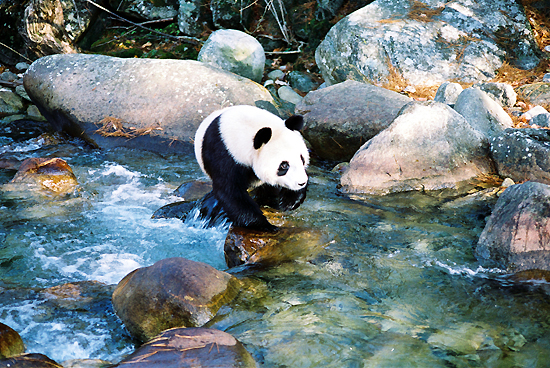
 China Tours
China Tours Tibet Tours
Tibet Tours China Theme Tours
China Theme Tours Off The Beaten Track
Off The Beaten Track Yangtze Cruises
Yangtze Cruises China Trip Planner
China Trip Planner Travel Agents
Travel Agents


We had a wonderful time in Tibet. We have learned a lot about this unique destination because of the wonderful guide Degyi who is so knowledge and always available towards our tours. We stayed at the Shangri-La Hotel Lhasa, and we would never imagine a Tibet travel could be so nice and amazing without the help of Degyi.
Also, thanks a lot to our Tibetan driver Mr.Wongdun for his safe driving and a good sense of service along the way.
We shall return Tibet in the near future!
P.B. and A. A - Europe
Tibet Travel
June 2018 (Private Tibet Journey from Kathmandu)

Posted: JUNE 6, 2013 By: Admin
Giant pandas, one of China's national treasures, are endangered but loved throughout the world. Living in the bamboo forests at an altitude of 2,000-4,000 meters in the country's western provinces including Sichuan, Shaanxi and Gansu, they subsist on a diet of bamboo and tree bark.
In the past 14 years, the China Conservation and Research Center for the Giant Panda has sent 16 pandas to zoos around the world. Their adorable appearance attracted a great number of visitors.
According to the third national giant panda survey published in 2003, there are 1,596 adult pandas in China, among which, 1,206 pandas live in Sichuan Province.
To protect the animals, several breeding bases and more than a dozen nature reserves for pandas have been built. The following are the top 10 reserves and breeding bases in China.
Longxi-Hongkou National Nature Reserve
|
|
|
Longxi-Hongkou National Nature Reserve |
Built in 1993, the Longxi-Hongkou National Nature Reserve is located in Longchi Town, 25 kilometers northwest of Dujiangyan city, Sichuan Province, covering an area of 34,000 hectares. It is on the west bank of upper reaches of Minjiang River, which belongs to the water source protection zone at upper reaches of Minjiang River.
The reserve is one of the most important panda habitats. About 10 to 20 wild pandas live in the subtropical mountain forest at 1,400-3,400 meters in altitude, enjoying the habitat's abundant food supply. The pandas share the reserve's natural resources with other precious wild animals such as golden monkeys and leopards.
Heishuihe Giant Panda Nature Reserve
|
|
|
Heishuihe Giant Panda Nature Reserve |
Heishuihe Giant Panda Nature Reserve is located in western Dayi County, Sichuan Province, covering an area of 450.2 square kilometers.
With massive forests and wide rivers flowing through the reserve, Heshuihe is home to a large variety of protected species, including the giant panda and golden monkey.
The reserve's altitude, moderate temperatures and humidity and other natural conditions are suitable for the growth, breeding and inhabitation of pandas. Abundant plant resources in the reserve provide pandas with their favorite bamboo throughout the year. About 30 wild pandas live in the area, one of the largest numbers of any reserve in Sichuan province.
A rescue center, an academic center and 10 protection centers for pandas have also been established in the reserve.
Wujiao Panda Nature Reserve
|
|
|
Wujiao Panda Nature Reserve |
Wujiao Panda Nature Reserve is located 45 kilometers southeast of Jiuzhaigou Town, covering an area of 36,349 hectares. In 1993, it became a provincial-level nature reserve.
There are 170 types of wild animals of 47 sections living in the reserve, including 26 nationally protected animals. The reserve houses 54 pandas in total.
Wanglang National Nature Reserve
|
|
|
Wanglang National Nature Reserve |
Established in 1965, Wanglang National Nature Reserve is one of the four earliest-built nature reserves for the protection of giant pandas, other rare wild animals and their habitat. Situated in Pingwu County, north of Mianyang city, it covers an area of 32,297 hectares.
The virgin forest in Wanglang is one of the best-preserved northwest Sichuan, an important area for the living of pandas which have connections with the panda species in Minshan Mountain.
Based on the statistics of the third national giant panda survey published in 2003, there were 27 pandas living in the reserve, all of them wild. The number now may have further increased. The panda's habitat inside the reserve covers an area of 19,701 hectares, accounting for 61 percent of the total area.
Shaanxi Foping Nature Reserve
|
|
|
Shaanxi Foping Nature Reserve |
Foping Nature Reserve is located in the Qinling Mountains, covering an area of 35,000 hectares. It was established in 1978, for the purpose of protecting giant pandas and their habitat. The reserve has been included in the Man and the Biosphere Program (MAB) of UNESCO.
The area's climate ranges from subtropical to temperate, warm and moist under the influence of the monsoon season, suitable for the survival of pandas. Farges cane and umbrella bamboo are the major food source for giant pandas here.
The area is home to a large amount of pandas. After over 30 years of protection, the number of pandas in the reserve has reached 110-130. In the area with high density of panda population, there is one panda every 0.48 km2, the densest of any reserve in the country.
A few brown-white giant pandas, instead of the typical black-white, have been found in Foping. In 1985 when they were found for the first time, a first-day cover of stamp for the uniquely colored pandas was released.
Tangjiahe Nature Reserve
|
|
|
Tangjiahe Nature Reserve |
As one of China's major giant panda habitats, the Tangjiahe Nature Reserve is located in Qingchuan County on the northwestern edge of Sichuan Basin, approximately a five-hour drive from downtown Chengdu.
Established in 1978, Tangjiahe Nature Reserve covers an area of 40,000 hectares. Wild pandas are spotted frequently in the area of 1,700-3,000 meters in altitude, where the arrow bamboo and other food resources are rich. About 60 pandas are known to be living in the reserve.
The reserve was named a Grade I nature reserve by World Wildlife Federation, making it one of the hotspots for the protection of global biodiversity.
Gansu Baishuijiang National Nature Reserve
|
|
|
Gansu Baishuijiang National Nature Reserve |
Established in 1978, Baishuijiang National Nature Reserve is located in Wenxian County, south of Gansu Province. The whole preservation zone is in the shape of a ribbon, 110 kilometers long east to west and 20 kilometers wide north to south. Covering an area of 183,799 hectares, the reserve is by now the largest reserve in the country and even in the world for the protection of giant pandas, and other rare wildlife. It was formally included in the Man and the Biosphere Program (MAB) of UNESCO in 2000.
The mild temperature, abundant rain, luxuriant forests and good ecological environment prove to be an ideal place for the growing of 11 types of bamboo - including giant pandas' favorite four types -- an encouraging sign that giant pandas can live and multiply well here.
The number of pandas living in the reserve has reached 140, accounting for 10 percent of the total number in China.
Chengdu Research Base for Giant Panda Breeding
|
|
|
Chengdu Research Base for Giant Panda Breeding |
Chengdu Research Base for Giant Panda Breeding, or Chengdu Panda Base, is a non-profit research and breeding facility for giant pandas and other rare animals. It is located in Futou Mountain, north of Chengdu, Sichuan Province, covering an area of 37.3 hectares.
Founded in 1987, Chengdu Panda Base started with 6 giant pandas that were rescued from the wild. Currently, the captive panda population in the base has grown to 108.
To protect the panda species, increase its population and help them adapt to life in the wild, the base has established a wilderness training area for pandas, preparing for release into their native habitat. Ten thousands of bamboo stalks, pandas' favorite food, have been planted in the area.
The base has established partnerships with many organizations, including foreign zoos such as Zoo Atlanta, to forward its conservation efforts.
Sichuan Bifengxia Panda Breeding Base
|
|
The base is divided into six zones including the feeding area, breeding area, research area, office area, bamboo area and living area. Currently there are 12 baby pandas ranging from 5 months to 9 months living in the "kindergarten."
The Overseas-born Panda Paradise in Bifengxia live six pandas born outside of China, such as Tai Shan born at the Smithsonian National Zoological Park in Washington D.C., and Su Lin and Zhen Zhen from the San Diego Zoo.
Each year, more than 1,000 people from all over the world apply to be volunteers at the base. Volunteers typically work from a few days up to three months.
Sichuan Wolong National Nature Reserve
|
|
|
Sichuan Wolong National Nature Reserve |
Built in 1963, the Sichuan Wolong National Nature Reserve is one of the earliest reserves in China. It is located in Wenchuan County, Aba Prefecture, only 120 km away from the urban area of Chengdu, and covers an area of 200,000 hectares.
The reserve, the home of more than 150 highly endangered giant pandas, is an ideal place for pandas to live and reproduce. The high altitude and humid air are suitable for the growth of pandas' favorite bamboos. The number of pandas in the reserve accounts for 10 percent of the total number of pandas in China, which is why Wolong is called "the hometown of pandas" and a "precious gene bank".
The reserve also has a field observation station for pandas and a panda museum.
In 1980, Wolong was approved to join the Man and the Biosphere Program (MAB) of UNESCO. The same year, the China Conservation and Research Center for the Giant Panda was jointly established here with World Wildlife Fund (WWF). By the end of 2010, the center had bred 165 pandas, accounting for 60 percent of the total number of artificially bred pandas.
Source: Xinhua![]() Keep reading:
Keep reading:
Splendid China Tours is based in Chengdu City, China's Southwestern Sichuan Province. We are Panda Tour specialist. Contact us now to start planning your next Panda Excursion with local people, share our first-hand information and get save!
China Trip Planner | Travel Agents | About Us | Why Us | Contact Us | How to Pay | How to Book - Terms & Conditions | Site Map
Copyright © 2010 - 2030 All Rights Reserved.


 0086-28-85711328
0086-28-85711328 0086-28-85546015
0086-28-85546015













